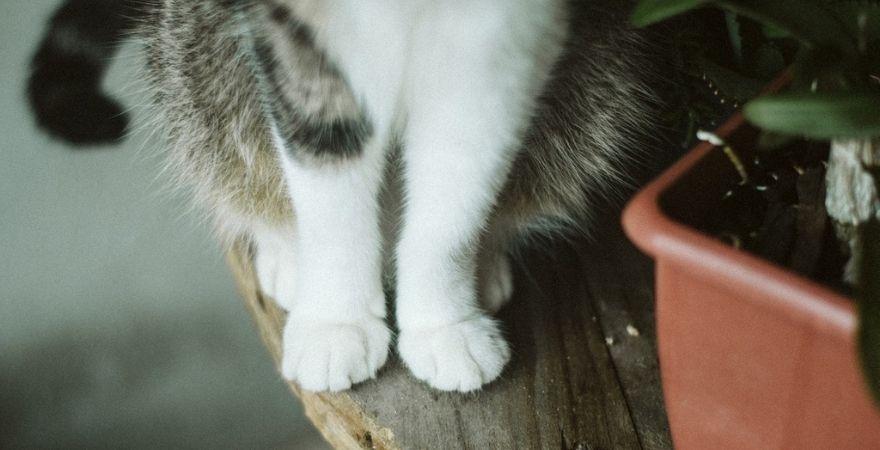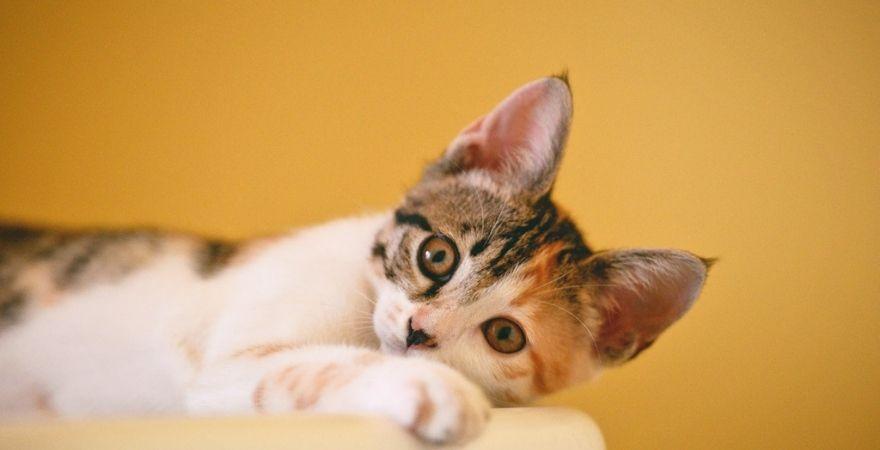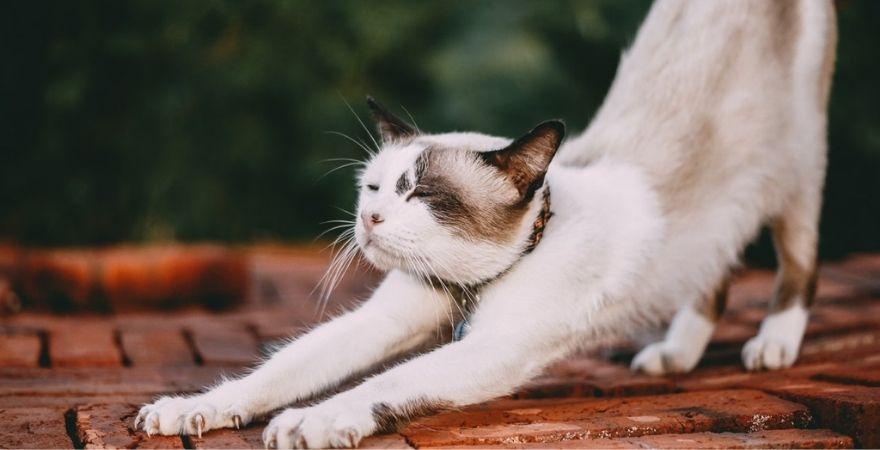This article is Part Two in a two part series about urinary problems in cats. If you haven’t read Part One, you might want to read that one first. In this article, we’ll build on the basics to set you up with some practical ideas and strategies about what to do if you think your cat might have urinary problems.
Once you’ve read this article you’ll know what your first steps should be, as well as your long-term options for medication, lifestyle change and dietary adjustment.
What to Do if Your Cat Has Urinary Problem
The last thing we want to do here at Scruffy Paws HQ is to bore you! But unfortunately the same basic advice always applies. With cats, the very best thing you can do is to err on the side of caution. If your cat is having trouble going to the bathroom, seems to be in pain, or is exhibiting any of the symptoms we talked about in Part One, the very first thing you should do is take your buddy to the vet.
Why?
There’s two big reasons. First, cats hide pain. If you can see symptoms of discomfort, there’s a good chance the situation has been around for a while and it may require rapid treatment. Secondly, cats crash fast. Once a feline develops one health problem, this can rapidly snowball into other issues. Giving your cat the best chance of a speedy recovery depends on getting to the vet and establishing a good treatment plan.
While urinary issues are always a priority, if you have a male cat who seems to have stopped urinating altogether, get to the vet immediately. This may require urgent treatment.
At the vet, your cat will likely receive a thorough physical evaluation. Urine samples may be taken (if possible) along with blood work, x-rays and ultrasound.
Medication Options

The first thing you should know about medicines for urinary tract treatment is this: Not all bladder problems can be fixed with medication.
For example, stress-related urinary problems might be partly managed through anti-anxiety medication, but a positive treatment outcome result is going to be far more dependent on dealing with the causes of stress and generally working with your ‘lil mate to get them happy and content again.
Other problems like spinal cord damage or genetic abnormalities are another problem a simple pill is not going to fix. Your vet is your best friend when it comes to ongoing treatment, and they’re going to give you solid advice on the what’s why’s and when’s of bringing your cat back to wellness.
Now, all that said, will medication play a role in your cat’s treatment? Quite possibly. Especially if your cat is diagnosed with a UTI, it’s likely your vet will run some labs to determine the right regimen of antibiotics and anti-inflammatory drugs.
Lifestyle Change
As discussed in Part One, stress can often be either the main cause of your cat’s urinary tract problems, or a contributing factor. Depending on your cat’s energy levels, it can’t hurt to take a bit of extra time to keep your cat occupied and enjoying life with toys.
But don’t force it! Just as you would with a human friend, if they clearly aren’t in the mood for fun or frolics, then be sure to let them get their rest (and get that vet appointment set up, stat!).
If your cat is experiencing litter box issues, there’s a few things you can do. First, be sure the litter box is clean. We’re talking fresh litter, nice clean surroundings, the whole shebang. Cats are fastidious little creatures, and a clean litter box will definitely help.
If incontinence is part of the problem, you may want to place a few litter boxes throughout the house. This will make the business of … well doing its business, that much easier. As with all things cat-related, be sure they have some privacy, too. Cats are a bit like humans and they like a quiet corner free of prying eyes.
Finally, there’s some solid research to suggest that “environmental enrichment” (meaning a stimulating, cat-friendly environment) can help some cats with urinary problems. It will depend on the cause of the problem, and your vet can advise on the ideal approach.
Nutritional Adjustment
Last, but by no means least, there’s dietary and nutritional change. Diet is going to be a really important aspect of long-term prevention. Remember, up to 80% of cats experience a recurrence of urinary tract problems, so the better their diet, the more likely it is they’ll stay relapse-free.
A healthy, well-balanced diet is going to be your cat’s best dietary foundation. It may also be worth considering nutritional supplements and specifically formulated vitamins which support your cat’s healthy urinary function.
Then there’s the big one: water! Keeping your cat hydrated becomes critical when your feline friend is dealing with urinary tract issues. Cats are notorious for not drinking enough, so you may need to use tricky strategies, like introducing more water to their food or placing water bowls strategically throughout the house.
And finally, you could try our Scruffy Paws UT Wellness Chews. If you are worried about UT infections in your kitty, or if you've had a cat thats been affected by them before we implore you to check out the Scruffy Paws UT Wellness Chews
Formulated by feline experts to the UT Wellness Chews specifically target the lining of your cats UT and Digestive tracts. Helping strengthen them and playing a hand in protecting them from crystals and debris in your cats urine. Not only that, the other active ingredients help reduce the 'bad bacteria' ability to stick to your cats UT wall... helping prevent FLUTD's in the first place!
Here's what one of our customers Sara said:
Good help for my male kitty who had blockage
I got these a little before release to test out on my male cat. He'd had a few FLUTD issues before, so I wanted to give him something that would help. So far, so good. He really likes eating these, and over the past few weeks he's been urinating well and not experiencing any pain.. so thumbs up from me.
==> If you want to support your cats UT health then click here
Listen To Your Cat!
And here endeth our guide to your cat’s urinary health. We hope you found it useful. As we always say at Scruffy Paws, the best skill you can learn as a cat-friend is the art of listening. Cats are subtle but they will tell you when something is wrong.
If you’re worried your cat might have urinary problems, the single best thing you can do is get them to the vet. Once they’re on a good treatment plan, the right combination of medical, lifestyle and nutritional treatments are likely to have your cattish companion happy again in no time.
Sources
[Cat Urinary Tract Infection Signs and Treatments | Hill's Pet] (https://www.hillspet.com/cat-care/healthcare/flutd)
[5 Signs Your Cat Has Urinary Tract Disease | petMD] (https://www.petmd.com/cat/centers/nutrition/slideshows/signs-your-cat-has-urinary-cat-disease)
[Feline Lower Urinary Tract Disease] (https://www.pethealthnetwork.com/cat-health/cat-diseases-conditions-a-z/lower-urinary-tract-disease-cats)
[Urinary Tract Disease in Cats] (http://www.vetstreet.com/care/urinary-tract-disease-in-cats)





10 comments
Great advice Mark. One symptom my cats displayed when they were affected with UTI and Blockage too was that they walked and moved in Slow Motion. Like every step was excruciatingly painful as hell. My Tabby Boy Clikey displayed the Slo-Mo affects, We saw the Vet immediately and tried the Stint Thing first for 3-4 days to clear the blockage but, that didn’t work. The last resort was of course was the Resection Operation. My Vet wanted to have another Dr. do it because She had said that she had only performed the operation on cadavers at school. I told her I had the utmost confidence in her skills and I wouldn’t blame her if things didn’t work out right and asked her to do it anyway. She agreed and Operated an hour or so later. 2 days later I took him home and his Butt looked like an Orangutans ass all blowed up like a balloon being swollen to the Max. Well it worked like a charm and within 2-3 weeks he was back to his old self being a normal kitty cat. Now 8 years later he is still Fine and Happy. It cost alright but, it was WELL worth EVERY Dollar I paid my vet and I would do it again if I had to in a Heartbeat. Keep up the GREAT work you do Mark !